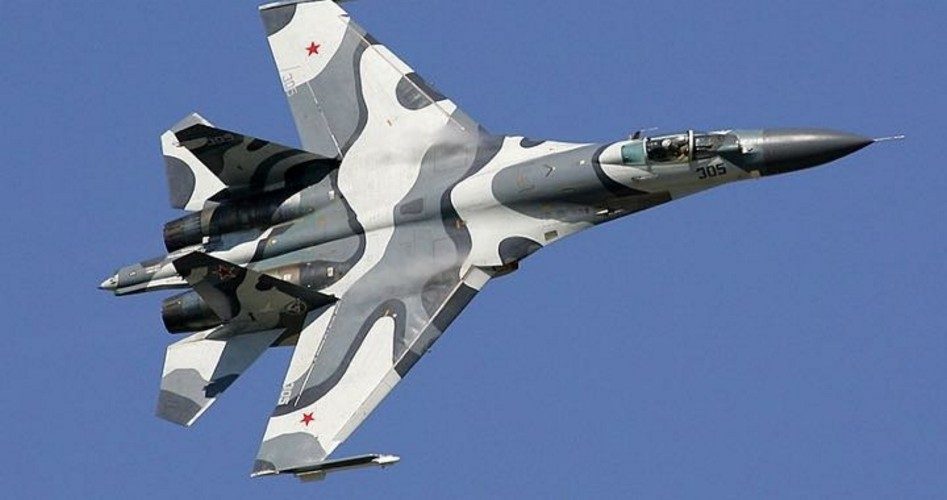
On January 29, a Russian Su-27 fighter jet closed to within five feet of a U.S. Navy EP-3 Aries reconnaissance plane flying in international airspace over the Black Sea, U.S. Naval Forces Europe said in a news release.
The statement from the Navy noted that the interaction was determined to be unsafe due to the Su-27 closing to within five feet and crossing directly through the EP-3’s flight path, causing the EP-3 to fly through the Su-27’s jet wash. It said the entire duration of the intercept lasted two hours and 40 minutes.
The Navy press statement continued:
The Russian military is within its right to operate within international airspace, but they must behave within international standards set to ensure safety and prevent incidents, including the 1972 Agreement for the Prevention of Incidents on and Over the High Seas (INCSEA). Unsafe actions increase the risk of miscalculation and midair collisions.
The statement also noted that the U.S. aircraft was operating in accordance with international law and did not provoke the Russian activity.
State Department spokeswoman Heather Nauert also made a statement about the incident, noting that the United States views it with “the highest level of concern.”
Nauert said that Russia’s military “flagrantly” violated international law and risked a midair collision. She described the incident as “the latest example of Russian military activities disregarding international norms and agreements.”
Reports about the incident in several news media organs, including AP, American Military News, The Hill, and the Washington Post, reviewed other incidents involving Russian, U.S., and NATO aircraft.
The Post reported that last June, a Russian fighter jet came within a few feet of a U.S. reconnaissance plane over the Baltic Sea and lingered by the side of the U.S. plane for minutes.
The Post article also cited a 2014 report from the European Leadership Network (ELN) entitled “Dangerous Brinkmanship: Close Military Encounters Between Russia and the West in 2014.” That report stated:
This ELN Policy Brief provides details of almost 40 specific incidents that have occurred over the last eight months (an interactive map is available here). These events add up to a highly disturbing picture of violations of national airspace, emergency scrambles, narrowly avoided mid-air collisions, close encounters at sea, simulated attack runs and other dangerous actions happening on a regular basis over a very wide geographical area.
Another report in The Hill noted that in November, a Russian fighter jet cut in front of a Navy surveillance plane, causing it to roll amid “violent turbulence.”
U.S. aircraft also intercept Russian planes, though they adhere to certain standards designed to minimize danger. The Hill report said that the Air Force recently released footage of “safe and standard” intercepts over the Baltic Sea. In those cases, the Air Force said, U.S. F-15s intercepted Russian jets because they were not broadcasting the appropriate codes required by air traffic control and had no flight plan on file.
American Military News also reported how U.S. aircraft deployed warning flares in such situations:
In December, a pair of U.S. Air Force F-22 Raptors intercepted and fired warning flares at two Russian Su-25 jets, after the Russian jets flew east of the de-confliction line that separates Russian- and U.S.-led coalition operating space over Syria.
The F-22s fired warning flares after the Russian aircraft crossed over the de-confliction line on multiple occasions, nearly causing a mid-air collision. The U.S. used a pre-established de-confliction hotline to diffuse the aircraft intercept.
An AP report observed that the United States has raised concerns several times over the last year about midair encounters between U.S. and Russian planes, including encounters above the Black Sea and Baltic Sea.
One incident back in 2001 was more than a close call, however — it resulted in an aerial collision between a U.S. EP-3E ARIES II reconnaissance plane and a Chinese People’s Liberation Army Navy J-8IIM fighter. The collision caused an international incident after the Chinese J-8IIM crashed and its pilot was killed. The EP-3 was able to make an emergency landing on Hainan, the southernmost province of China, consisting of several islands in the South China Sea.
The crew was accused of killing the Chinese pilot, and they were detained by Chinese authorities.
After several days, the crew was returned to the United States while the aircraft remained in China. An American team was later permitted to enter Hainan in order to dismantle the aircraft, which was subsequently airlifted back to the United States for reassembly and repair.
So far, it is too early to determine if the Trump administration will issue any warnings to the Russians against endangering U.S. aircraft. It might also be helpful if our military concentrated on defending the United States instead of being spread around the world in areas that are not germane to our own national defense. There is nothing in the vicinity of the Black Sea that poses a threat to America.
Photo of Russian fighter: Dmitriy Pichugin via Wikipedia



